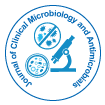
Journal of Clinical Microbiology and Antimicrobials
Open Access
+44-77-2385-9429

+44-77-2385-9429
Commentary - (2022)Volume 6, Issue 2
Coccidioidomycosis, commonly known as cocci, valley fever, as well as California fever, desert rheumatism or San Joaquin Valley fever, is a mammalian fungal disease caused by Coccidioides immitis or Coccidioides posadasii. Coccidioidomycosis is endemic in certain parts of the United States in Arizona, California, Nevada, New Mexico, Texas, Utah, and northern Mexico.
C. immitis is a dimorphic saprophytic fungus that grows in the soil as a subfungus and forms a spherical form in the host organism. It is found in soil in certain parts of the southwestern United States, especially in California and Arizona. It is also commonly found in northern Mexico and parts of Central and South America. C. immitis is dormant during long periods of drought, and then develops as a mold with long filaments that break into aerial spores when it rains. The spores, known as arthroconidia, are blown into the air by soil disturbance, such as during construction, farming, low winds, or occasional dust events or earthquakes. Windstorms can also cause epidemics far from endemic areas. In December 1977, a wind storm in an endemic area around Arvin, California led to several hundred cases, including deaths, in non-endemic areas hundreds of miles away.
Coccidioidomycosis is a common cause of community-acquired pneumonia in endemic areas of the United States. Infections usually occur as a result of inhalation of arthroconidia spores after soil disturbance. The disease is not contagious. In some cases, the infection may recur or become chronic.
In 2022, valley fever was reported to be increasing for years in California's Central Valley (1,000 cases in Kern County in 2014, 3,000 in 2021); experts said cases could increase in the American West as the climate makes the landscape drier and warmer.
Diagnosis
The diagnosis of coccidioidomycosis relies on a combination of the infected person's signs and symptoms, radiographic findings, and laboratory results. This disease is commonly misdiagnosed as bacterial community-acquired pneumonia. Fungal infection can be demonstrated by microscopic detection of diagnostic cells in body fluids, exudates, sputum, and biopsy tissue using the Papanicolaou or Grocott methenamine silver staining methods. These spots may show spherules and surrounding inflammation.
With specific nucleotide primers, C. immitis DNA can be amplified by Polymerase Chain Reaction (PCR). It can also be detected in culture by morphological identification or by using molecular probes that hybridize to C. immitis RNA. C. immitis and C. posadasii cannot be distinguished cytologically or by symptoms, but only by DNA PCR.
Indirect evidence of fungal infection can also be achieved by serological analysis detecting fungal antigen or host IgM or IgG antibody produced against the fungus. Available tests include Tube-Precipitin (TP) tests, complement fixation tests, and enzyme immunoassays. TP antibody is not found in Cerebrospinal Fluid (CSF). The TP antibody is specific and used as a confirmatory test, while the ELISA is sensitive and therefore used for initial testing.
If the meninges are involved, the CSF will show abnormally low glucose, elevated protein, and lymphocytic pleocytosis. CSF eosinophilia is rarely present.
Complications
In immunocompromised patients, serious complications can occur, including severe pneumonia with respiratory failure and bronchopleural fistulae requiring resection, pulmonary nodules, and possible disseminated disease, where the infection spreads throughout the body.
The disseminated form of coccidioidomycosis can devastate the body, causing skin ulcers, abscesses, bone lesions, swelling of the joints with severe pain, inflammation of the heart, urinary tract problems and inflammation of the lining of the brain, which can lead to death.
Citation: Olay T (2022) Diagnosis of Coccidioidomycosis and its Complications. J Clin Microbiol Antimicrob. 06: 133
Received: 15-Jul-2022, Manuscript No. JCMA-22-20604; Editor assigned: 19-Jul-2022, Pre QC No. JCMA-22-20604 (PQ); Reviewed: 02-Aug-2022, QC No. JCMA-22-20604; Revised: 09-Aug-2022, Manuscript No. JCMA-22-20604 (R); Published: 16-Aug-2022 , DOI: 10.35248/JCMA.22.6.133
Copyright: © 2022 Olay T. This is an open-access article distributed under the terms of the Creative Commons Attribution License, which permits unrestricted use, distribution, and reproduction in any medium, provided the original author and source are credited.